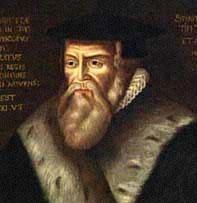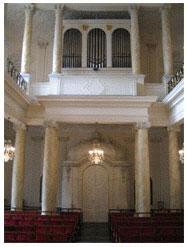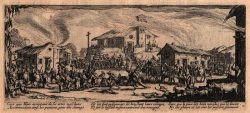The Thirty Year War (1618-1648)
The Thirty Year War, fought over both religious and political issues, devastated Germany in the XVIIth century. At the beginning it was a religious conflict between the Protestant princes and the House of Hapsburg, who were the sovereigns of the Holy Empire. Later, it degenerated into a European war due to the intervention of foreign powers, notably Sweden and France.
The defenestration of Prague
In 1608, the Protestant princes, led by the Palatinate Elector Frederic V, formed the Evangelical Union. In their turn, the Catholics set up the Holy League with Maximilian of Bavaria at its head.
In 1609 Emperor Rudolf II delivered the “Letter of Majesty”, which guaranteed freedom of religion in Bohemia. But in 1618, as Emperor Mathias did not fulfill the commmitment, the Protestants rebelled. May 23 was the third defenestration of Prague (the first two were in 1419 and 1483), considered the beginning of the Thirty Years War. When Matthias died, they refused to recognize Ferdinand II as heir and proclaimed the Elector Palatine Frederick V, leader of the Protestants, king of Bohemia. The Protestants were crushed at the White Mountain (1620).
In 1624, the war escalated due to the intervention of Christian IV, King of Denmark, who came to the rescue of the Protestants. The Danes were defeated at the battles of Tilly and Wallenstein (Treaty of Lubeck in 1629). The Catholics were utterly victorious and the House of Hapsburg was at its most powerful ; it already ruled Austria, Bohemia and Hungary, a major part of Italy, Spain, as well as the Spanish-controlled parts of the Low Countries.
The intervention of Sweden, followed by that of France
The Protestants remained hostile because of Ferdinand II’s Edict of Restitution (1625), which forced them to give back the ecclesiastical property which they had previously seized. Gustave II Adolphe, the King of Sweden, a Lutheran who received financial aid from Richelieu, came to the rescue of the Protestant princes (but he also had his eye on the Baltic) : he led his troops to brilliant victories against the Catholics until the battle of Lützen ‘(1632), where he died.
When the Imperial armies became very powerful, France (under Richelieu) began war against the Empire. The Spanish, who were approaching Paris, were routed by Condé at Rocroi (1643), while Turenne and the Swedish troops invaded Bohemia and Bavaria.
Peace was restored by the treaty of Westphalia in 1648. Negotiations started in Munster (1644) : the United Provinces were opposed to Spain, and France was an enemy of the Holy German Empire. Negotiations between Sweden and the Empire took place in Osnabruck in 1645. The beneficiary was France, given clear possession of the Three Bishoprics (Metz, Toul, Verdun), which had been trust territories since 1552. It annexed Low Alsace and the city of Brisach in Germany added to Pignerol in Piedmont returned to France as early as 1631 after the Mantua succession war. Sweden’s territories spread as far as the Baltic, and western Pomerania was also annexed (the eastern part had been annexed by the Brandenburgs). Both the Low Countries and the Swiss cantons were officially recognized as being independent.
The House of Hapsburg lost a great deal of its former power and Germany, having lost a third of its population, was financially ruined and in complete political disarray.
Associated notes
-

Protestantism in Germany
The Lutheran Reformation movement was a crucial event in German history. This theological and religious revolution had a major effect on German politics, language and culture. Today Germany has several... -

Protestantism in the Scandinavian countries
At the beginning of the XVIth century, Scandinavia consisted of two kingdoms : one was made up of Norway and Denmark and the other Sweden and Finland. They both loosely belonged... -

Protestantism in Bohemia and Moravia (Czech Republic)
In the XIVth century, Jean Hus introduced the Reform Movement to Bohemia and Moravia (these two countries are now known as Czechoslovakia), where it caught on quickly with the local... -

Protestantism in Belgium
Although the Low Countries and Belgium (which was in fact part of the latter for several centuries) had shared a common history in the past, the consequences of the events... -

Protestantism in the Low Countries
The history of Dutch protestantism basically consists of a long-drawn out battle against Spain, who held sway over the country in the second part of the XVIth century and at...


